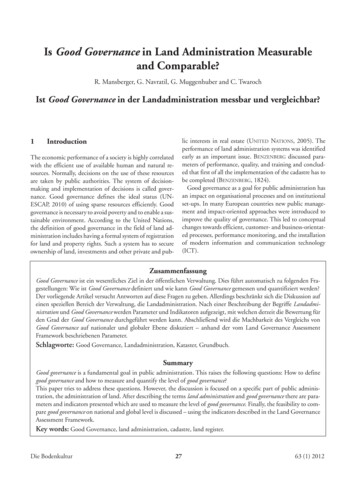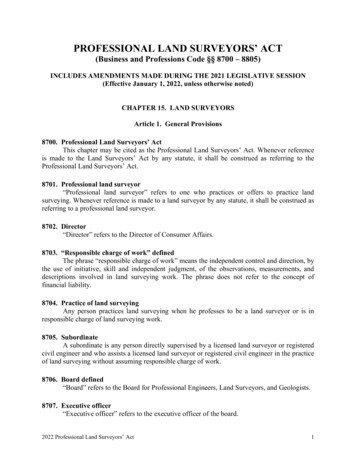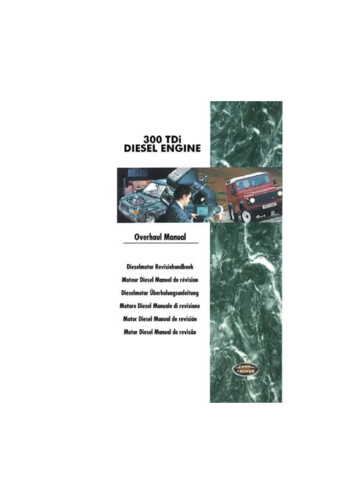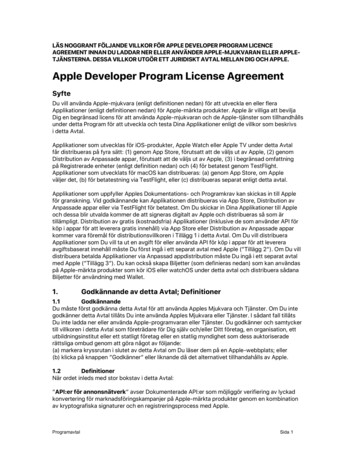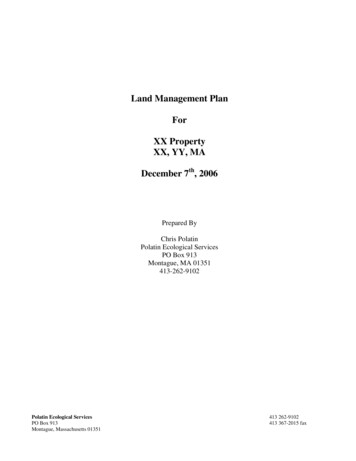
Transcription
Land Management PlanForXX PropertyXX, YY, MADecember 7th, 2006Prepared ByChris PolatinPolatin Ecological ServicesPO Box 913Montague, MA 01351413-262-9102Polatin Ecological ServicesPO Box 913Montague, Massachusetts 01351413 262-9102413 367-2015 fax
Land Management PlanXX Property, YY, MA1. INTRODUCTIONPolatin Ecological Services (PES) was asked to evaluate the southeast portion of the XXproperty for invasive exotic plant species and prepare a management plan for thisapproximately 5 acre portion. We spent 5 hours evaluating the site on October 31st, 2006at which time we used a GPS unit (Garmin GPS Map 76) to delineate management areaboundaries. In each management area we collected specific information pertaining to theinvasive plant species present, their abundance, density, percent cover, stem diameterrange, and heights. We also considered special features such as wetlands in ourevaluation, in so far that wetlands would determine our suggested management activities.The entire XX property consists of approximately 27.3 acres of woodlands and forestedwetlands which will be more concisely described from a forestry perspective in the 2006Forest Management Plan by licensed forester John XX. PES created a GIS map toaccompany this management plan (PES November 6th 2006). This map includes theboundaries for the proposed management areas as well as the Department ofEnvironmental Protection’s (DEP) wetlands layer (10/2006 acquired through Mass GIS).The map is included as Figure 1 on page 12 of this document. This wetlands layer doesnot constitute official wetlands delineation for the site, however it is helpful to use theDEP layer to visualize the extent of wetlands present on the site and to inform thismanagement plan. I believe the wetlands layer represented is fairly accurate for the 5acres that I visited within the delineated management areas.The forested wetlands represented on the map consist of Red Maple Swamp as defined bythe Massachusetts Natural Heritage and Endangered Species Program (NHESP) (Swainand Kearsley 2001). The NHESP information for Red Maple Swamp is included asAppendix B in that it provides a basic description for the reference ecosystem that can bepotentially restored once the invasive plants are controlled. In addition, I observed atussock sedge (Carex stricta) dominated wetland complete with hummock-hollowtopography within a lower depression portion of the red maple swamp within InvasivePlant Management Area 4 (denoted on the map in Figure 1 with a purple star). From anecological perspective I would rank this area as a priority for invasive plant control andhabitat restoration activities.Note: Reference ecosystems give us a target to shoot for when practicing ecologicalrestoration.We discovered eight invasive plants in the survey area. These plants include multiflorarose, Morrow’s honeysuckle, Japanese barberry, glossy buckthorn, European linden,winged euonymus, Asiatic bittersweet, and purple loosestrife. All of these plants with theexception of European linden are considered “invasive” by the Massachusetts InvasivePlants Advisory Group (MIPWG 2003). I am including European linden for control inthis management plan because I believe it is behaving like an invasive plant on the site.Furthermore, I have observed and controlled a one-half acre monoculture of the plant ona state hatchery property in Palmer, Massachusetts where forester XX also believed theplant exhibited invasive tendencies.Polatin Ecological ServicesHabitat Restoration, Conservation Planning, Land Stewardship
Land Management PlanXX Property, YY, MAManagement Goal: The goal of this plan is to restore the native plant community withinthe Invasive Plant Management Units in order to promote the natural regeneration ofnative species for present and future forest integrity. Invasive plants will be selectivelyremoved over time in order to restore the biodiversity to these areas.Objectives: Reduce invasive plant cover by 75% through management actions initiatedin 2008, 90% by the end of the 2009 growing season, and 99% after 2010 follow-uptreatments. Scouting and manual techniques (pulling) will be ongoing activities after theinitial control techniques are completed.Note: A good management plan always sets management goals and objectives.2. OVERVIEW OF WEED MANAGEMENT APPROACHInvasive plant control should be considered as part of an overall site management andrestoration program. It is important to focus on the species and communities that aredesirable to protect, rather than on simply eliminating weeds. In this plan we will setpriorities for the control or elimination of invasive plants that have already established onthe site, according to their actual and potential impacts on native species andcommunities, particularly on our conservation targets. We will suggest action only whencareful consideration indicates leaving the invasive plant unchecked will result in moredamage than controlling it with available methods.We propose the use of an adaptive management strategy. First, we establish and recordthe goals for the site. Second, we identify species that block us from reaching these goalsand assign them priorities based on the severity of their impacts. Third, we considermethods for controlling them or otherwise diminishing their impacts and, if necessary, reorder priorities based on likely impacts on target and non-target species. Fourth, wedevelop weed control plans based on this information. Fifth, the plan is implemented,and results of our management actions monitored. Sixth, we evaluate the effectiveness ofour methods in light of the site goals, and use this information to modify and improvecontrol priorities, methods and plans. Finally, start the cycle again by establishingnew/modified goals.We set priorities in the hope of minimizing the total, long-term workload. Therefore, weact to prevent new infestations and assign highest priority to existing infestations that arethe fastest growing, most disruptive, and affect the most highly valued area(s) of the site.We also consider the difficulty of control, giving higher priority to infestations we thinkwe are most likely to control with available technology and resources.To develop the management control plan, literature and other reference sources werereviewed for each of the plants listed above. Their biology, origin and distribution, andpossible control options (biological, herbicide, and mechanical) were taken into account.Control priorities were developed using the National Park Service’s Alien Plant RankingPolatin Ecological ServicesHabitat Restoration, Conservation Planning, Land Stewardship
Land Management PlanXX Property, YY, MASystem (APRS) (Hiebert and Stubbendieck 1993). The APRS is used to develop aquantifiable methodology for ranking individual invasive species for control within agiven area. This process analyzes each invasive species based on interactions betweensignificance of impact and feasibility of management or control. The data formscontaining the assessed characteristics for each species is located in Appendix A. Theresults of the analysis are shown in Table 1.Note: This NPS method for ranking invasive plants is enormously helpful whenevaluating multiple invasive plants on larger parcels.A realistic and effective invasive plant control program usually takes a minimum of threeyears. Even after this initial period it will be necessary for someone to keep an eye out fornew invasive plant patches and manage them appropriately. Usually it is enough to handpull small seedlings as they are discovered just as one would do in a garden setting.Without this vigilant attention to scouting, the initial three year investment inmanagement can be lost within 5 years. Many invasive plant seeds are dispersed by windand birds. If there are invasive plants in the surrounding landscape then it is likely thatthey will find their way back. Another confounding factor involves the seed’s longevityfor different species of plant. An extreme example involves the invasive plant Scotchbroom on the west coast of the US whose seeds can remain viable under ideal conditionsfor up to 70 years. For the most part, many woody plant seeds in the Northeast canremain viable in the soil for up to 7 years.Note: Invasive plant management is a longterm investment. Eradication of an invasiveplant on a property is usually not possible. Control is possible. Aftercare is veryimportant to keeping the site clean after the initial work is completed. Training volunteersto scout the property for new infestations, mapping, and reporting to the coordinator iskey to the process. This way small scale inexpensive activities can be coordinated toprevent further spread.Integrated Vegetation Management (IVM): Integrated Vegetation Management (IVM)is a subset of Integrated Pest Management (IPM). IPM can simply be defined as asystematic approach to common sense pest management. The IPM approach gained anaudience in the 1960's in response to the increasing failures of agricultural pest controlefforts that relied too heavily on pesticides. In effect, pest managers realized that manymethods used prior to the availability of pesticides were still viable, and a balancedapproach combining proven techniques and the new man-made pesticides was moreeffective and environmentally sound than sole reliance on pesticides.IVM can be thought of as preventive maintenance for vegetation. Listed below are somefundamental principles of an IVM program: Whether a plant needs to be controlled depends on where it is, and what it is. Non-problem (desirable) plants provide a valuable service by occupying spacethat a pest plant might otherwise occupy. Therefore, the preservation of desirable plants is equally important as controllingpest plants.Polatin Ecological ServicesHabitat Restoration, Conservation Planning, Land Stewardship
Land Management PlanXX Property, YY, MA Invasive weeds are a form of pollution. Keeping your weeds out of adjacentproperties is an integral part of IVM.A fundamental aspect of IVM is using as many approaches as possible, in a coordinatedfashion. Weed control methods can broadly be grouped into the following categories: Cultural - practices that promote the growth of desirable plants, which reduces theopportunities for weeds to grow. Mechanical - physical damage or removal of all or part of the weed. Cutting andgrubbing are common examples. Biological - using one organism to control another. Classic examples are therelease of insects to feed on specific plants, such as purple loosestrife. Densegroundcover that excludes weeds can be a form of biological control. Chemical - the selective and judicious use of herbicides.We will recommend management actions that combine approaches tailored to exploitweaknesses in the individual invasive plants. Herbicides are very powerful tools ininvasive plant management and should be used sparingly at the most effective time basedon the phenology of the individual plant species. For example, the cut stump method ofherbicide application applies a concentrated solution of herbicide to freshly cut plantstems which absorb the herbicide directly into the root system where it can systemicallyact on the entire root system.Our recommendations for the herbicide type and solution are derived from the Rights-ofWay Sensitive Area Material List (February /Sensitive Area Materials.htm. Thegeneral use herbicides recorded on this list pose very little risk to the health of humans,wildlife, and sensitive resources such as wetlands. The recommended solutions arederived from the lowest rate recommended on the herbicide label.3. INVASIVE PLANT SPECIES OF CONCERNNote: There were originally 7 invasive plants on the subject property, but I onlyused multiflora rose for the sample below.Make sure the recommendations are grounded in citable literature, research and/or theverifiable experiences of land managers.Multiflora rose (Rosa multiflora)Multiflora rose is a member of the Rosaceae (Rose) Family. It is a perennial shrub thatforms dense, impenetrable clumps of vegetation. Isolated plants can produce clumps upto 33-feet in diameter. Bushes can grow to a height of 6 to 10-feet and occasionallyupwards of 15 feet.Polatin Ecological ServicesHabitat Restoration, Conservation Planning, Land Stewardship
Land Management PlanXX Property, YY, MAThe number of stems for each plant varies from few to many. Stems originate from thebase, and are erect and arching to more or less trailing or sprawling. Stems grow to 13feet long and are armed with stout recurved prickles. Leaves are alternate, pinnatelycompound, and 3 to 4-inches long with 5 to 11 (usually 7 or 9), 1 to 1.6-inch longleaflets. Flowers are 0.5 to 0.75-inches across and number 25 to 100 or more in long orpointed panicles. Fruits are globular to ovoid, 0.25-inches or less in diameter. Seeds areangular achenes (Munger 2002b).Individual plants may produce up to 500,000 seeds per year. Most plants develop fromseeds that fall relatively close to the parent plant. Some seeds are dispersed by birds andmammals. Fruits remain on the plant and dry to a dense, leathery capsule. Seeds mayremain viable in the soil for 10 to 20 years, but detailed information on seed longevity islacking. Multiflora rose also reproduces asexually by root suckering and layering.Origin and DistributionNative to Japan, multiflora rose occurs throughout eastern North America fromNewfoundland and Nova Scotia south to northern Florida, and west to Minnesota,Nebraska, and Texas. It is also distributed along the West Coast from British Columbia toCalifornia. The origins of multiflora rose in North America stem from its use as arootstock species for ornamental roses and as a fencerow plant (Munger 2002b).Multiflora rose frequently colonizes roadsides, old fields, pastures, prairies, savannas,open woodlands, and forest edges, and may also invade dense forests where disturbanceprovides canopy gaps. It is most productive in sunny areas with well-drained soils.Multiflora rose is tolerant of a wide range of soil and environmental conditions, but is notfound in standing water or in extremely dry areas. Its northern distribution is thought tobe limited by intolerance to extreme cold temperatures, but specific information islacking (Munger 2002b).Management Considerations and OptionsMultiflora rose is a serious pest plant in many areas of North America. It can invadepasture areas, degrade forage quality, reduce grazing area and agricultural productivityand cause severe eye and skin irritation in cattle. Multiflora rose can spread rapidly,severely restricting access to pasture and recreational areas with "impenetrable thickets".Its characteristic dense growth of foliage and stems inhibits growth of competing nativeplants (Munger 2002b).Physical Control – Manual/Mechanical MethodsMultiflora rose can be controlled by periodic mowing or cutting of individual plants. Forpre-existing infestations, 3 to 6 mowings or cuttings per year, repeated for 2 to 4 years, isrecommended. Painting or spraying cut stems with herbicides expedites control by killingroot systems and preventing resprouting. Another approach is to follow an initial mowingwith a foliar application of herbicide once plants have resprouted (see herbicide controlsection below). In high quality natural areas, cutting individual stems may be preferableto mowing, since repeated mowing might damage sensitive native plants. Mowingequipment may be susceptible to frequent flat tires from multiflora rose thorns. Periodicannual mowing can also prevent multiflora rose seedlings from becoming established.Removal of entire plants may be feasible in high quality natural areas when populationsPolatin Ecological ServicesHabitat Restoration, Conservation Planning, Land Stewardship
Land Management PlanXX Property, YY, MAare sparse enough. Removal of the entire root system is required to ensure no regrowthfrom suckering (Munger 2002b).Physical Control – Prescribed BurningIn fire-adapted communities, periodic prescribed burns will presumably retard multiflorarose invasion and establishment, although descriptions of the use of prescribed burningfor control of multiflora rose are lacking (Munger 2002b). Burning is not an option on theXX site due to the close proximity of homes.Biological Control – Insects/PathogensPresently, three biotic agents have become destructive pests on multiflora rose and showpotential to provide eventual significant biological control. They are: Rose rosette disease, a mite-vectored virus Rose seed chalcid, a torymid wasp that infests and kills developing rose seeds Rose stem girdler, a beetle whose larvae girdles and kills plant canes.Most attention to date has centered on rose rosette disease, but the rose seed chalcid alsomay have major future impact in biocontrol (Munger 2002b). The small population sizeand isolated populations of multiflora rose on the site would not support insectpopulations and thus biocontrols are not recommended for this species.Biological Control – GrazingThe small population size of multiflora rose on the site in combination with the fact thatthis species can cause severe eye and skin irritation in cattle prevents grazing from beingrecommended for control.Herbicide ControlWhere appropriate, herbicides may be an effective means of controlling multiflora rose,especially when used in combination with other methods. Table 1 contains a list ofherbicides that have been tested and judged effective for controlling multiflora rose inNorth America, as well as a brief discussion of important considerations regarding theiruse. This is not intended as an exhaustive review of herbicide control methods. For moreinformation regarding appropriate use of herbicides against invasive plant species innatural areas, see The Nature Conservancy’s Weed Control Methods Handbook (Tu et al.2001).Polatin Ecological ServicesHabitat Restoration, Conservation Planning, Land Stewardship
Land Management PlanXX Property, YY, MATable 1. Herbicides effective at controlling multiflora rose.HerbicideConsiderationsGlyphosateGlyphosate is a post-emergent herbicide recommended for "cut-stem"method. It is a non-selective herbicide that kills most plants. It has lowtoxicity to animals and rapidly binds to soil particles making itrelatively immobile. It can also be broadcast at a rate of 2 quarts peracre or as a 1 percent spray-to-wet foliar application.TriclopyrTriclopyr is recommended for "cut-stem" method and for dormantseason basal bark treatment. It may volatilize when exposed to hightemperatures (80 to 85 F). It is selective against dicots. The esterformulation of triclopyr can be persistent in aquatic environments andshould not be applied in wetland habitats.Dicamba andDicamba plus2,4-DDicamba is selective against broadleaf vegetation. It is best appliedduring flowering and rapid growth (May-June). It is alsorecommended for dormant-season basal bark treatment. Dicamba mayvolatilize when exposed to high temperatures (80 to 85 F). It is highlymobile in soil and may contaminate ground water. We do notrecommend this herbicide for the XX site.Applying herbicides to cut stems can hasten mechanical control by translocatingherbicides to root systems and preventing resprouting. In addition, applying herbicidesdirectly to the target plant in this manner reduces damage to surrounding native plants,and presumably reduces off-target effects. Cut-stem treatment is effective late in thegrowing season (July-September) (Munger 2002b).Foliar spraying is effective throughout the growing season as long as leaves are fullyformed. Some herbicides may volatilize when temperatures exceed 80 to 85 F and arebest applied in early spring. Some variation in herbicide effectiveness during differentstages of the growing season has been observed, but is probably not related to differencesin carbohydrate reserves (Munger 2002b).Dormant season application is also effective, and further reduces nontarget mortality.Basal bark treatment, applied to the lower 18 to 24 inches of the stem and onto the rootcrown, is a recommended herbicide control method for dormant season application.Plants should be dormant and several weeks from bud break (usually January- March),and treatments should only be conducted when soil is not frozen, snow-covered, or watersaturated to avoid runoff. Follow-up monitoring and retreatment during the subsequentgrowing season may be required to ensure effectiveness (Munger 2002b).Herbicides tend to kill rose plants from the peripheral roots inward toward the crown.Thus, subsequent mechanical mowing or pulling of treated plants often eliminates anyremaining live plant parts and hastens re-establishment of grass cover. Because deadPolatin Ecological ServicesHabitat Restoration, Conservation Planning, Land Stewardship
Land Management PlanXX Property, YY, MAtopgrowth also protects emerging rose seedlings, promptly removing it facilitates futurefield maintenance (Munger 2002b).Note: There is a lot of information here. Perhaps more than you need in most cases.Urgency: Results from the Alien Plant Ranking System indicate a high level of urgencyto control multiflora rose on the XX property (see Appendix A and Table 1 for moreinformation).Current distribution on property: Multiflora rose was observed in Management Areas 1,2, and 3 (Figure 1). It is the dominant plant in the wetlands present in IPM Area 2 and ifleft untreated can potentially invade IPM Area 4 wetlands. Since the plant has thecompetitive ability to exist in both wetlands and uplands, there is potential for the plant tofurther invade other areas.4. RESULTS FROM RANKING CRITERIAResults from the Alien Plant Ranking System (Hiebert and Stubbendieck 1993) arerepresented in Figure 1 and Table 2. The ranking data sheets are provided in Appendix A.Figure 1. Invasive Plant Ranking Graph for XX property.Polatin Ecological ServicesHabitat Restoration, Conservation Planning, Land Stewardship
Land Management PlanXX Property, YY, MATable 2. Ranking of invasive plant species at XX property, XX, MA.SpeciesCurrent InnateTotal FeasibilityUrgencylevel of Ability toof Controlimpact become aPestMultiflora apanese barberry 6172355LowEuropean lindenNANANANANAGlossy buckthorn23416417HighWinged Euonymus 13274025MediumAsiatic bittersweet 15435820HighPurple loosestrife26144035MediumPolatin Ecological ServicesHabitat Restoration, Conservation Planning, Land Stewardship
Land Management PlanXX Property, YY, MAFigure 1. Invasive plant management areas within southeast portion of XXproperty, XX, MA.Polatin Ecological ServicesHabitat Restoration, Conservation Planning, Land Stewardship
Land Management PlanXX Property, YY, MA4. DESCRIPTION/PRESCRIPTION FOR MANAGEMENT AREASInvasive Plant Management Area 1Description of area: Approximately 0.59 acres. Southeast corner is the intersection of xxStreet with xx Lane. A diversity of invasive plants are present in abundance with little tono native component in understory. The IPM Area 1 western boundary is the wetlandline; therefore all of IPM Area 1 appears to be outside of the wetlands.Invasive plants present with measurements:Invasive plantJapanese barberryEuropean lindenMorrow’shoneysuckleGlossy buckthornMultiflora roseWinged euonymus*Density coverclass2: low4: medium/high4-5: medium/highStemdiameter 1”1-2”1”Height rangeNotes2’5-11’3-5’NoneNoneNone3: medium 1”6”-2’3: medium2: low 1” enmire (1959) cover class system (Class 1: 0-5%; Class 2: 6-25%; Class 3: 26-50%; Class 4: 5175%; Class 5: 76-95%; Class 6: 96-100%).Management Recommendations:1. Cut stems 1” diameter and paint stems with 25% Garlon 4 in basal oil solutionwith indicator dye. Stems should be hauled out to xx Lane and chipped at astaging area. Wood chips should be used on the property trails to minimize soilcompaction and prevent trail erosion. Timing: This application is very effective atany time except for spring when the sap is rising (March/April).2. Foliar spray invasive plants 1” diameter with 2-5% Garlon 3A, surfactant,indicator dye, and drift control agent. Timing: Best effect is between June andearly August.3. Mow/cut material that was foliar sprayed at least 6 weeks after the foliarapplication.4. Follow-up herbicide applications will be necessaryInvasive Plant Management Area #2Description of area: Approximately 1.95 acres. IPM Area 2 appears to be nearly all a redmaple swamp wetland (see Appendix B for natural community information). Formapping purposes and based on the uniformity of the habitat and invasive plants present Iextended the management unit west of the brook (running north to south). The worstthreat to this area is the high density of multiflora rose which dominates the understory(Figure 2).Polatin Ecological ServicesHabitat Restoration, Conservation Planning, Land Stewardship
Land Management PlanXX Property, YY, MAInvasive plants present with measurements:Invasive plantJapanese barberryEuropean lindenMorrow’shoneysuckleGlossy buckthornMultiflora rose*Densitycover class1: very low2: low2: lowStemdiameter 1”1”1”Heightrange2’3-6’3-5’2: low5: high 1” 1”6”-2’1-3’NotesNoneOccurs on fringe upland portionsSeveral very large plants ( 2”diam., 7’ tall)NoneThere are large rose plants ( 6’)along north central portion ofmngmt. unit. and along brook.*Daubenmire (1959) cover class system (Class 1: 0-5%; Class 2: 6-25%; Class 3: 26-50%; Class 4: 5175%; Class 5: 76-95%; Class 6: 96-100%).Management Recommendations:1. Cut stems of invasive plants 1” diameter or greater and paint stems with 50%Rodeo herbicide in water solution with indicator dye. Stems should be hauled outto XX Lane and chipped at a staging area. Wood chips should be used on the XXproperty trails to minimize soil compaction and prevent trail erosion. Timing: Thisapplication is very effective at any time except for spring when the sap is rising(March/April).2. Foliar spray invasive plants 1” diameter with 2-5% Rodeo, surfactant, indicatordye, and drift control agent. Timing: Best effect is between June and early August.3. Mow/cut material that was foliar sprayed at least 6 weeks after the foliarapplication.4. Follow-up herbicide applications will be necessaryNotes:IPM Area #2 is within a wetland therefore we are recommending use of the wetlandapproved herbicides Rodeo or Accord Concentrate (active ingredient glyphosate) (EPAReg. No. 62719-324) along with a specific wetland surfactant called Chemsurf 90 nonionic surfactant.REFERENCESHiebert, R.D. and J. Stubbendieck. 1993. Handbook for Ranking Exotic Plants forManagement and Control. U.S. Department of Interior, National Park Service,Denver.Polatin Ecological ServicesHabitat Restoration, Conservation Planning, Land Stewardship
Land Management PlanXX Property, YY, MAMassachusetts Invasive Plant Working Group (MIPWG). 2003. The Evaluation o f Nonnative Plant Species for Invasiveness in Massachusetts, the final report of the plantevaluation subcommittee of the Massachusetts Invasive Plant Working Group.Swain, P.C. & J.B. Kearsley. 2001. Classification of the Natural Communities ofMassachusetts. Version 1.3. Natural Heritage & Endangered Species Program,Division of Fisheries & Wildlife. Westborough, MA.Tu, M. 2003. Element stewardship abstracts for multiflora rose, Morrow’s honeysuckle,Japanese barberry, glossy buckthorn, winged euonymus, Asiatic bittersweet, andpurple loosestrife. The Nature Conservancy’s Wildland Invasive Species Team ,Dept. of Vegetable Crops & Weed Sciences, University of California, Davis, CA95616. ar.html.Tu, M., C. Hurd, and J.M. Randall. 2001. Weed Control Methods Handbook: Tools andTechniques for Use in Natural Areas. The Nature Conservancy. April 2001 TheInvasive Species Initiative website: http://tncweeds.ucdavis.edu/handbook.html.Clement, C., R. Warren, G. Dreyer and P. Barnes. 1991. Photosynthesis, water relations andfecundity in the woody vines American and Oriental bittersweet (Celastrus scandensand C. orbiculatus). Annual Meeting Botanical Society of America, Poster Abstract inAmerican Journal of Botany 78(6 suppl.):134-135.Polatin Ecological ServicesHabitat Restoration, Conservation Planning, Land Stewardship
Management Goal: The goal of this plan is to restore the native plant community within the Invasive Plant Management Units in order to promote the natural regeneration of native species for present and future forest integrity. Invasive plants will be selectively removed over time in order to restore the biodiversity to these areas.

